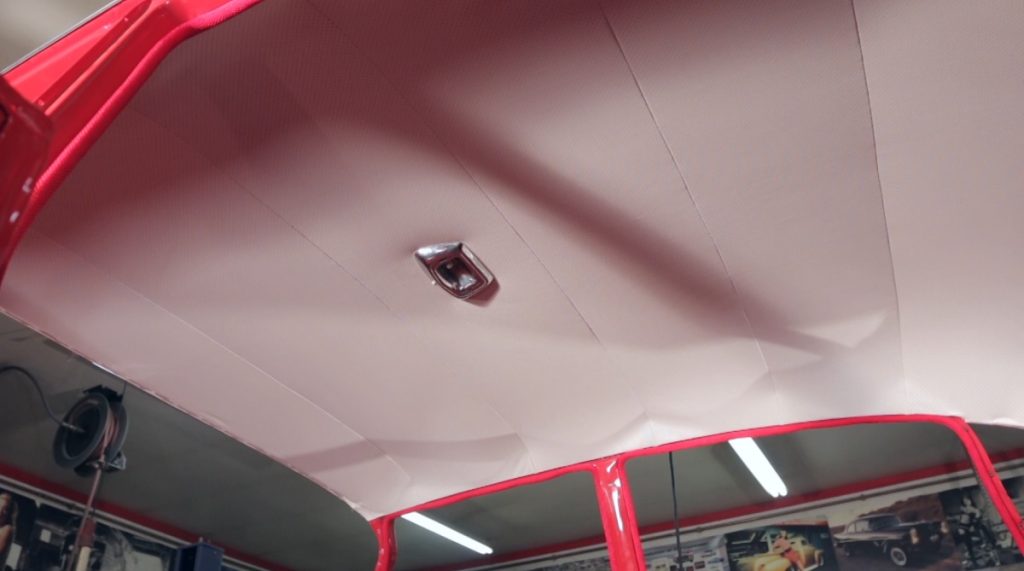In the world of classic trucks, preserving the authentic charm of your vehicle is not just a hobby; it’s a passion that involves hands-on maintenance and restoration. When it comes to the interior, a key element that often needs attention is the headliner. Learning how to make a headliner for an old truck is not only a practical skill but also an opportunity to infuse your personality into your prized possession. In this extensive guide, we’ll take a deep dive into each step of the process, providing valuable insights, tips, and additional information to ensure you embark on this DIY journey with confidence.
Table of Contents
- Understanding the Importance of a Quality Headliner
- Materials You’ll Need
- Step-by-Step Guide to Making a Headliner
- Additional Tips for a Professional Finish
- Personalizing Your Headliner
- Maintaining and Cleaning Your DIY Headliner
- Expert Tips for Crafting the Perfect Truck Headliner
- 1. Material Matters: Choose Quality Fabrics
- 2. Precision in Measurements: Measure Twice, Cut Once
- 3. Mind the Foam Backing: Strike a Balance
- 4. Adhesive Application: Even and Adequate Coverage
- 5. Work in Sections: Manageable Progress
- 6. Curves and Contours: Navigate with Care
- 7. Original Features Replication: Attention to Detail
- 8. Ventilation During Adhesive Work: Safety First
- 9. Explore Creative Options: Personalize Your Headliner
- 10. Regular Maintenance: Prolong the Lifespan
- Frequently Asked Questions About Crafting Truck Headliners
- 1. What is the best fabric for a truck headliner?
- 2. How do I remove the old headliner without causing damage?
- 3. Do I need to replace the foam backing when making a new headliner?
- 4. Can I use regular glue instead of adhesive spray?
- 5. How do I handle curves and contours in the truck’s ceiling?
- 6. Can I personalize my headliner with additional features?
- 7. What is the recommended drying time for adhesive spray?
- 8. How do I clean and maintain my DIY headliner?
- 9. Can I use any fabric for a DIY headliner?
- 10. How long does it take to complete the entire headliner crafting process?
- Conclusion
Understanding the Importance of a Quality Headliner
Beyond its visual impact, a headliner serves several functional purposes in your classic truck. It provides insulation, reducing external noise and temperature fluctuations. Additionally, it adds a layer of comfort during drives, making it a crucial component of your vehicle’s interior. Choosing the right material for your headliner is not just about aesthetics; it’s about creating an environment that enhances your driving experience.
Materials You’ll Need
Before embarking on your headliner crafting journey, it’s essential to gather the necessary materials. Here’s a detailed list to ensure you have everything you need:
- Headliner fabric: Choose a material that complements the overall aesthetic of your truck’s interior. Options range from classic vinyl to more modern suede or even custom prints.
- Foam-backed fabric: This additional layer not only enhances insulation but also provides a plush appearance to your headliner. Consider the thickness of the foam based on your preferences.
- Adhesive spray: Opt for a high-quality adhesive to ensure a strong and durable bond. Consider eco-friendly options if you’re conscious of the environment.
- Screwdriver: A versatile tool for removing the existing headliner. Ensure it’s the right size for the screws or clips in your truck.
- Utility knife: Essential for precise trimming and shaping. Invest in a sharp blade to achieve clean cuts without damaging the fabric.
- Fabric glue: While adhesive spray is crucial for the bonding process, fabric glue comes in handy for securing the edges and any additional features you may want to incorporate.
- Clothespins: These simple tools play a crucial role in holding fabrics together during the bonding process. Consider having a variety of sizes for different areas of the headliner.
Step-by-Step Guide to Making a Headliner
1. Remove the Old Headliner
Begin the process by removing the existing headliner. Use a screwdriver to take out any screws or clips securing it in place. Pay close attention to the original installation, as this knowledge will guide you during reinstallation.
2. Measure and Cut the Fabric
Accurate measurements are crucial for a seamless fit. Measure the dimensions of your truck’s ceiling and cut the headliner fabric accordingly. Leave a few extra inches on each side to account for any adjustments during installation.
3. Prepare the Foam-Backed Fabric
Cut a piece of foam-backed fabric to match the dimensions of the headliner fabric. This additional layer enhances insulation and provides a plush appearance to your headliner. Consider the thickness of the foam based on your preferences for comfort and aesthetics.
4. Apply Adhesive to Both Materials
Using an adhesive spray, evenly coat the backside of both the headliner fabric and the foam-backed fabric. Allow a few minutes for the adhesive to become tacky, ensuring a better bond during attachment. Take note of the drying time, and work in sections if needed.
5. Align and Attach the Fabrics
Carefully align the two fabrics, ensuring that they match up perfectly. Press them together, smoothing out any wrinkles or bubbles to achieve a tight bond. Use clothespins along the edges to secure the fabrics while the adhesive sets. Take your time during this step to ensure precision.
6. Trim Excess Material
Once the adhesive has fully set, use a utility knife to trim any excess fabric. Follow the contours of the truck’s ceiling, maintaining precision for a professional finish. Be cautious during this step to avoid damaging the newly applied headliner.
7. Reinstall the Headliner
Reverse the removal process to reinstall the new headliner. Ensure a snug fit and secure it in place using the original clips or screws. Take your time during this step to guarantee that the headliner sits perfectly in its designated space. Check for any loose areas and reinforce the attachment if necessary.
Additional Tips for a Professional Finish
- Work in a Well-Ventilated Area: Adhesive sprays can have strong fumes, so choose a workspace with adequate ventilation. Consider wearing a mask if working in a confined space.
- Precision is Key: Take your time with measurements and cuts to ensure a precise fit. Rushing through this process can lead to uneven edges and a less-than-perfect result.
- Replicate Original Features: If your original headliner had specific features like indentations or curves, replicate them in your DIY project for an authentic look. This attention to detail enhances the overall aesthetic of your classic truck’s interior.
Personalizing Your Headliner
This DIY project offers ample opportunities for personalization. While the basic steps guide you through the process, don’t hesitate to infuse your unique style into the project. Consider experimenting with different fabric textures, patterns, or even incorporating additional features like built-in LED lighting for a modern touch. Personalization not only adds character to your truck but also makes the crafting process more enjoyable. (See Also: What to Put Under Car Seat to Protect Leather? Protect Your Car’s Leather Seats)
Maintaining and Cleaning Your DIY Headliner
Now that you’ve invested time and effort into creating a custom headliner, it’s essential to know how to maintain and clean it. Regular vacuuming with a soft brush attachment helps remove dust and debris. For stains, use a mild fabric cleaner and a soft cloth, avoiding excessive moisture to prevent damage.
Expert Tips for Crafting the Perfect Truck Headliner
As you embark on the journey of creating a headliner for your vintage truck, consider these expert tips to ensure a flawless result. Crafting a headliner involves more than just adhering fabric to the ceiling; it’s an opportunity to elevate your truck’s interior. Let’s explore some key insights to guide you through this rewarding DIY process.
1. Material Matters: Choose Quality Fabrics
When selecting headliner fabric, opt for high-quality materials that not only match your aesthetic preferences but also provide durability. Consider factors like colorfastness, resistance to wear, and ease of cleaning. Investing in premium fabric ensures a long-lasting and visually appealing result.
2. Precision in Measurements: Measure Twice, Cut Once
Precision is paramount in crafting a headliner that fits seamlessly. Measure the dimensions of your truck’s ceiling accurately, double-checking before making any cuts. This meticulous approach minimizes errors and ensures a snug and professional fit during installation.
3. Mind the Foam Backing: Strike a Balance
The foam-backed fabric plays a crucial role in enhancing insulation and comfort. However, striking the right balance is key. Choose a foam thickness that provides sufficient padding without compromising the overall fit. Too much foam can lead to an uneven surface, affecting the headliner’s appearance.
4. Adhesive Application: Even and Adequate Coverage
Achieving a strong bond between the headliner fabric and foam backing requires even and adequate adhesive coverage. Use a high-quality adhesive spray and ensure both surfaces are evenly coated. Allow sufficient drying time before pressing the fabrics together to prevent bubbles or uneven adhesion.
5. Work in Sections: Manageable Progress
Breaking down the headliner installation into manageable sections allows for better control and attention to detail. Apply adhesive and attach fabrics in stages, focusing on one area at a time. This approach minimizes the risk of errors and ensures a smoother overall process.
If your truck’s ceiling features curves or contours, navigate them with care. Take extra time to mold the fabric around these areas, ensuring a seamless finish. Consider making small relief cuts in the fabric to accommodate curves, allowing for a more natural and professional appearance.
7. Original Features Replication: Attention to Detail
To maintain the authenticity of your vintage truck, replicate any original features present in the previous headliner. This could include specific indentations or curves. Attention to these details enhances the overall aesthetic and preserves the classic charm of your vehicle.
8. Ventilation During Adhesive Work: Safety First
Working with adhesive sprays requires proper ventilation. Ensure your workspace is well-ventilated, and consider using a mask to protect yourself from fumes. Prioritize safety throughout the crafting process to make it a positive and health-conscious experience. (See Also: What Material is Used for Car Doors? Exploring the Best Options for Automotive Door Construction)
9. Explore Creative Options: Personalize Your Headliner
While following the basic steps is essential, don’t shy away from creative exploration. Consider unique fabric patterns, textures, or even integrating additional features like hidden pockets or custom stitching for a personalized touch. Your headliner should not only be functional but also a reflection of your style.
10. Regular Maintenance: Prolong the Lifespan
After successfully crafting your headliner, adopt a regular maintenance routine. Vacuuming with a soft brush attachment and using a mild fabric cleaner for stains will help preserve its appearance. Avoid excessive moisture during cleaning to prevent damage to the fabric and underlying structure.
By incorporating these expert tips into your headliner crafting process, you’ll not only achieve a professional result but also enjoy a rewarding journey of transforming your vintage truck’s interior. Happy crafting!
Frequently Asked Questions About Crafting Truck Headliners
As you delve into the world of crafting a headliner for your vintage truck, questions may arise. To provide clarity and assistance, we’ve compiled some frequently asked questions along with detailed answers. Whether you’re a seasoned DIY enthusiast or a beginner, these FAQs cover essential aspects of the headliner crafting process.
1. What is the best fabric for a truck headliner?
Selecting the right fabric is crucial for both aesthetics and durability. Opt for automotive-grade headliner fabric, which is often foam-backed and designed for longevity. Vinyl and suede are popular choices due to their resilience and ease of maintenance.
2. How do I remove the old headliner without causing damage?
To remove the old headliner, carefully locate and remove screws or clips holding it in place. Use a screwdriver and work gently to avoid damaging the surrounding trim. Take note of how the original headliner was installed for guidance during reinstallation.
3. Do I need to replace the foam backing when making a new headliner?
Yes, the foam backing is essential for insulation and appearance. It adds a layer of comfort and helps create a smooth surface. When crafting a new headliner, ensure you choose a foam-backed fabric or add a separate foam layer for optimal results.
4. Can I use regular glue instead of adhesive spray?
It’s not recommended to use regular glue for attaching the headliner fabric. Adhesive spray is specifically designed for this purpose, providing an even and secure bond. Regular glue may not offer the same level of adhesion and can result in a less durable finish.
5. How do I handle curves and contours in the truck’s ceiling?
When encountering curves or contours, work slowly and use relief cuts in the fabric to allow for a smooth fit. Take extra care to mold the fabric around these areas, ensuring it adheres seamlessly for a professional appearance.
6. Can I personalize my headliner with additional features?
Absolutely! Personalizing your headliner allows you to add unique touches to your truck’s interior. Consider features like hidden pockets, custom stitching, or even integrated LED lighting for a modern flair. (See Also: Is Red Leather Car Interior Tacky? Exploring the Pros and Cons of Red Leather Upholstery)
7. What is the recommended drying time for adhesive spray?
Drying times can vary based on the specific adhesive spray used. Check the product label for guidance, but as a general rule, allowing at least 15-30 minutes for the adhesive to become tacky before attaching the fabrics is advisable.
8. How do I clean and maintain my DIY headliner?
Regular maintenance is key to preserving your headliner’s appearance. Use a vacuum with a soft brush attachment for routine cleaning. For stains, use a mild fabric cleaner and a soft cloth. Avoid excessive moisture to prevent damage to the fabric and underlying structure.
9. Can I use any fabric for a DIY headliner?
While creativity is encouraged, it’s essential to choose fabric suitable for automotive interiors. Ensure the fabric is durable, colorfast, and easy to clean. Automotive-grade headliner fabric is specifically designed to withstand the conditions inside a vehicle.
10. How long does it take to complete the entire headliner crafting process?
The time required depends on factors such as the complexity of your truck’s ceiling, your level of experience, and the materials used. On average, the process can take a day or more. Working patiently and methodically is key to achieving the best results.
Feel free to explore more about crafting your truck headliner in our comprehensive guide. If you have additional questions, don’t hesitate to reach out for personalized assistance. Happy crafting!
Conclusion
Embarking on the journey of creating a headliner for your old truck might initially seem challenging, but with the right materials, patience, and attention to detail, you can transform your vehicle’s interior. This DIY project is not just about functionality but also about expressing your passion for classic trucks.
As you cruise down the road in your revamped vintage truck, the satisfaction of knowing you played a hands-on role in its restoration adds an extra layer of joy to the driving experience. Enjoy the process, embrace the creativity it allows, and revel in the unique character you bring to your classic truck. Happy crafting!


